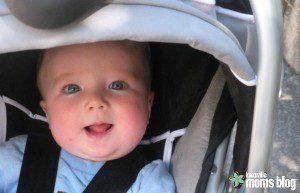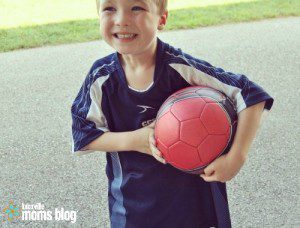
Our children have grown magnificently over the past few years. Now at eight, five, and four, we are out of the baby years, when we had two in diapers and I watched my fair share of 3am infomercials (those mamas in the trenches, I salute you!). When our second child, August, was born in 2010, he was a preemie, weighing in at five pounds, seven ounces. Aside from a touch of jaundice, he was a strong, healthy baby boy and we were sent home with our bundle of awesome. Then something seemed off.
I first began to notice something was wrong when he would sleep at night. I would lay him down on his back, and when I would check on him, he always, always, had his head turned to his left. I would move his head for him while he was sleeping, but he would always turn it back. As a result of this, he began to develop a flat spot on the side of his head. I also began to notice that his head control was not up to par, and that he would lean his head to one side in the car seat. I voiced my concerns to the pediatrician and he diagnosed August with congenital muscular torticollis.
Babies with torticollis may also develop positional plagiocephaly (asymmetrical head shape) because they’ll often sleep with their head turned to the side, which explained why August had been sleeping in such a position, and the flatness on the side of his head. The pediatrician asked me to show him pictures of August on my cell phone, and he pointed out that progressively you could see him begin to tilt his head to one side in the pictures. I had taken a picture of August in his car seat an hour prior to his appointment while we were at lunch, and sure enough, his head was tilted. I was devastated. I really thought I had done something wrong or not given him enough tummy time, which I believed he was doing quite frequently. As it turns out, August was born with a condition called torticollis in latin, or “twisted neck.” If a child has this condition, the baby’s head will be tilted to one side while the chin is turned to the other side.
When a baby is born with the condition, it’s called congenital torticollis. About 1 in 250 infants are born with torticollis. (Ten to 20 percent of babies with torticollis also have hip dysplasia, in which the hip joint is malformed.) Congenital torticollis is most often due to tightness in the muscle that connects the breastbone and the collarbone to the skull. (It’s called the sternocleidomastoid muscle). This is called congenital muscular torticollis. This tightness might have developed because of the way the baby was positioned in the uterus (with the head tilted to one side) or because the muscles were damaged during delivery.
Thankfully, it was nothing that I had done or did not do, but a condition formed in utero. The doctor instructed me to do “stretches” with August, twice a day, 20-30 seconds per stretch. This required both myself and my husband. One of us held his shoulders down while the other stretched the neck muscles. We did three types of stretches: straight back, chin to shoulder, and ear to shoulder, all lasting 20-30 seconds each. I also needed to make him look to his right as much as possible. I also upped the tummy time like crazy, making him stretch that neck even more.

When I took him back the following month for a five month checkup and a follow up for torticollis, the pediatrician was amazed to see how well he was doing. He was very frank with me in stating that he had intentions of sending us to an orthopedist for physical therapy, or a helmet if the conditions with his head worsened. Thankfully, August’s condition had improved so dramatically, that we could continue our stretches at home, helmet and physical therapy free. We were told that August may never crawl, but by the time he was six months old he was working on sitting up, rolling over on both sides, and using an exersaucer. And he did indeed crawl and he began walking at fifteen months, just two weeks before his brother was born. Now, at age five, he is as physically able as any other child his age and has not had any of the issues that we considered as he was an infant. We are grateful.
Just thought I would share our experience with congenital muscular torticollis in case any of your little ones have been diagnosed with this neck condition. What are your experiences with torticollis?





















Thank you so very much for sharing your story! I came across this blog while searching for pictures of older children who had torticollis as babies. My daughter was diagnosed with torticollis and a mild case of plagiocephaly when she was about 6 weeks old, and she is now 4 months old. She has had a lot of improvement very recently, with a few ups and downs that came along with growth spurts and issues with her acid reflux, which, combined with the torticollis and overall upper body weakness, made tummy time a miserable endeavor for this little monkey. She’s getting so much better now, although she has started fighting the stretches to the point that I have to trick her into doing them – very frustrating. But your story has given me hope that she, like your son, can be a healthy, active child one day. He looks so happy! : )